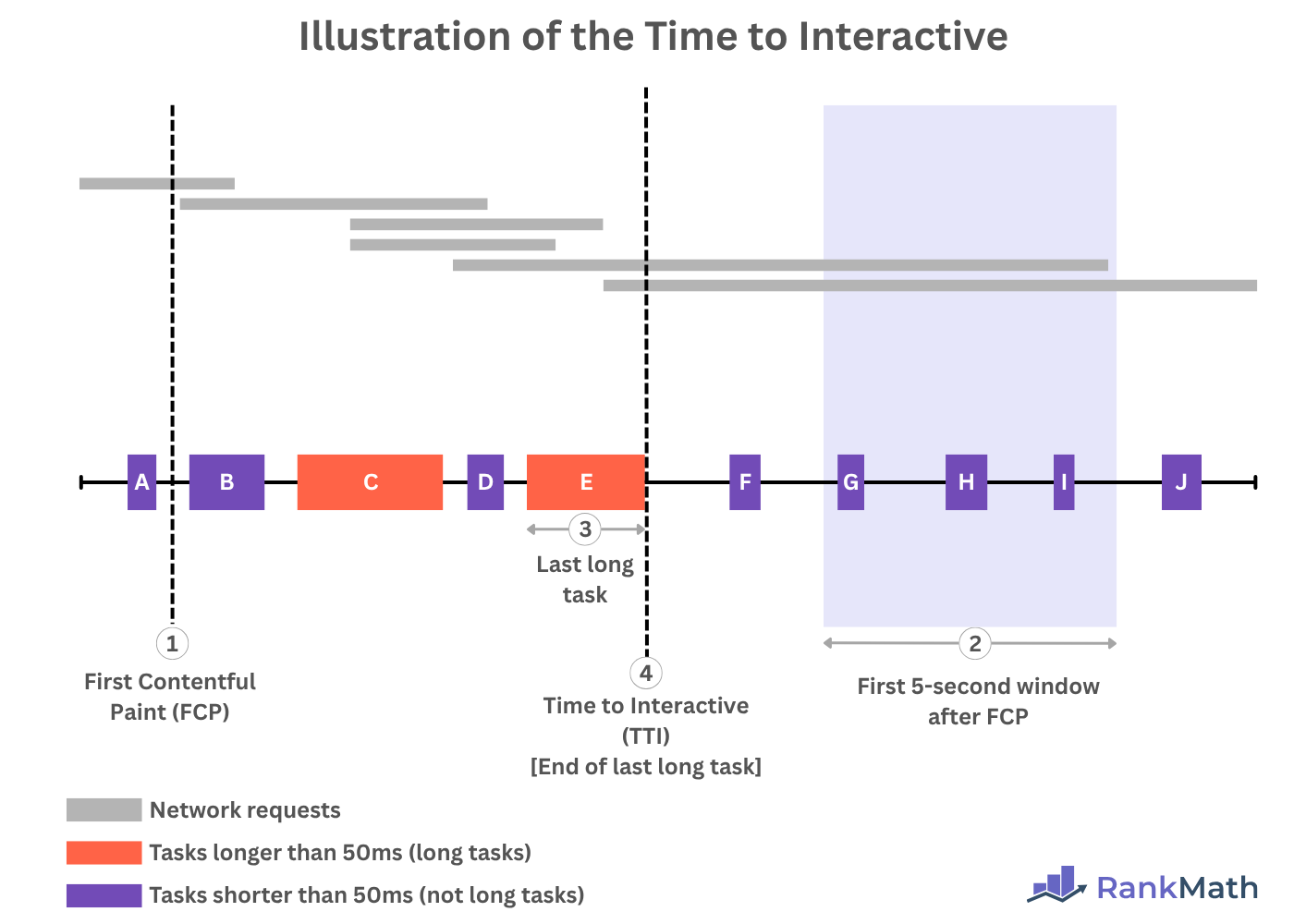What Is Time to Interactive (TTI)?
Time to interactive (TTI) is a web performance metric that measures how long it takes for a page to become reliably interactive. In other words, it evaluates how long it takes a site to display useful content that reliably responds to user input, such as mouse clicks, keyboard clicks, and screen taps.
A webpage is considered to be reliably interactive when it meets multiple criteria, including:
- It displays useful and visible content
- Its main thread is idle without any long tasks for at least 5 seconds
- It responds to user input within 50 milliseconds
Time to interactive is measured from the moment the page begins loading and is completed when the main thread is free of long tasks and event handlers respond quickly to input (usually within 50 milliseconds).
To identify the time to interactive:
- Identify the first contentful paint (labeled 1)
- Identify the first five-second window after the first contentful paint, during which there are no long tasks and no more than two network GET requests (labeled 2)
- Identify the last long task before the five-second window (labeled 3)
- The time to interactive is the end of the last long task (labeled 4)
If there are no long tasks before the 5-second window, then the first contentful paint will also be the time to interactive.

With that said, the time to interactive has been deprecated, and no longer counts towards the performance scores reported in the Herramienta PageSpeed Insights.
In this article, we’ll cover:
Why the Time to Interactive Was Deprecated
Lighthouse used to measure the time to interactive and reported it in the Performance field of the PageSpeed Insights tool. However, Lighthouse stopped reporting it after the February 2023 release of Lighthouse v10.0.
Google mentioned that the deprecation was necessary because the time to interactive was too sensitive to slow or delayed requests and long tasks. Both events may introduce inconsistencies that can result in Lighthouse erroneously concluding that a webpage is noninteractive when it actually is.
This made the time to interactive unreliable in certain situations, which ultimately caused Google to deprecate it from Lighthouse and PageSpeed Insights.
Importance of the Time to Interactive
The time to interactive is helpful for uncovering situations where a webpage may appear interactive when it actually isn’t. This situation usually occurs because bloggers often optimize their webpages for speed without bothering about interactivity.
This means a webpage can load its content, including its interactive elements, quickly. However, the element will not work because the main thread is blocked or the JavaScript file for the element has not been loaded.
This means the element will not respond to user actions, such as mouse clicks, keyboard clicks, and screen taps, until the relevant JavaScript file loads and the main thread is free.
This is frustrating for visitors, who may think the page is broken. Such visitors can leave the page as a result, leading to missed conversions, revenue, and a higher bounce rate for the blogger.
In the case of search engines like Google, this can lead to issues such as hacer pogo. It also hurts the user experience of their users. So, they use the time to interact to evaluate the time it takes for the visible elements in the viewport to become reliably interactive.
Difference Between Time to Interactive and Interaction to Next Paint
The time to interactive is closely related to the interaction to next paint (INP), which is another metric that measures responsiveness.
The interaction to next paint is an SEO metric for evaluating the responsiveness of a webpage. It is one of the three metrics evaluated as part of the Elementos vitales web básicos, which is itself used to assess the page experience, which is a factor de clasificación.
However, the time to interactive is a lab metric. That is, it is evaluated in a controlled environment using systems that simulate real-life devices and network conditions.
In contrast, the interaction to next paint is a field metric. That is, it is evaluated using real-user data collected when actual visitors visited the webpage and interacted with an element. In this case, the interacton to next paint measures how long it takes the webpage to respond to an input.
The time to interactive is also evaluated once during the page load process, while the interaction to next paint evaluates for all interactions on the page. It then reports the longest interaction as the interaction to next paint for the page.